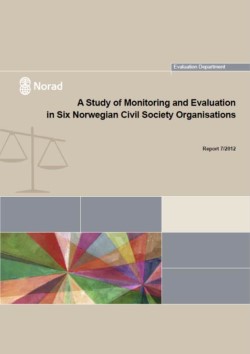A Study of Monitoring and Evaluation in Six Norwegian Civil Society Organisations
About the publication
- Published: April 2013
- Series: Evaluation study
- Type: Evaluations
- Carried out by: Andante - tools for thinking AB
- Commissioned by: Norad
- Country:
- Theme: Civil society
- Pages: 164
- Serial number: 7/2012
- ISBN: 978-82-7548-682-8
- ISSN: --

Background
Civil Society Organisations (CSOs) have always been leading participants in development and humanitarian activities, in channelling large amounts of development cooperation money from both government funds and other sources
into a range of projects and programmes. Like others, they are expected to show the results of their activities and for that purpose they have developed systems for monitoring and evaluation.
Purpose
This study provides an overview and assessment of the role of monitoring and evaluation in six of the largest Norwegian CSOs. It has the following objectives;
- to map the evaluation function in this group of Norwegian CSOs;
- to assess the evaluation function, most notably in regard to the relevance and quality of the reports produced and the systems in place for making use of the results and ensuring evaluations are also used for learning;
- to make recommendations which could strengthen the evaluation function to enhance its role in relation to quality assurance and results, and for knowledge sharing and learning, both internally and externally.
Conclusions
The study concludes that in many ways the monitoring and evaluation functions across the organisations perform well: there is a strongly supportive evaluation culture; many staff members are interested in evaluation and have practical experiences of monitoring and evaluation; and they have been exposed to training. The quality of evaluation reports is by and large satisfactory, even though (as with other agencies) there is certainly scope for improvement and for more extensive coverage.
Policies, structures and functions have evolved over recent years and the organisations have all invested in systems development and in human resources for monitoring and evaluation, though many remain quite informal.
There are of course significant differences between these six organisations in respect of the detailed design of structures and processes for monitoring and evaluation. But the similarities are more striking and the M&E functions of the six CSOs are quite different from the M&E functions in, for example, domestic public administration, the private sector, and in international agencies.
Recommendations
It is essential that all these positive developments are maintained and built-upon
and we have found willingness for this to happen. Our recommendations focus
on six areas of action:
- Policy guidance that can be made more strategic, clearer and more comprehensive
- Engaging the governing Boards, to increase the visibility and status of the monitoring and evaluation functions and to provide the Boards with results information.
- Review of the functions of M&E units, which have developed organically, but may need to be reformed to make sure there are not roles and responsibilities around monitoring and evaluation that ‘fall between the
chairs’. - Establishing budgets and budget follow-up as financial information on the M&E functions is not available but will be necessary to assess also the value for money of this function.
- Developing and standardising key processes, in particular management response, quality assurance, and the better anchoring of the evaluation process within the organisation.
- Review of the incentives and obstacles to learning and use, which is an approach that must take a holistic perspective of the organisation.
